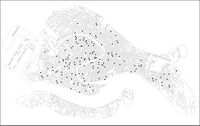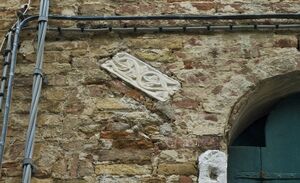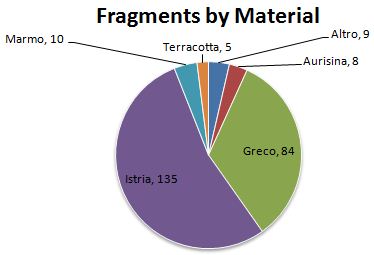Fragments: Difference between revisions
No edit summary |
No edit summary |
||
| (One intermediate revision by the same user not shown) | |||
| Line 6: | Line 6: | ||
}} | }} | ||
Fragments (''frammenti''), like their name suggests, are small broken pieces of other [[Public | Fragments (''frammenti''), like their name suggests, are small broken pieces of other [[:Category:Public Art|artwork]], and are a sub-set of [[Material Culture|material culture]]. When larger carvings were destroyed, the remains were often discarded. However, on occasion, remaining fragments were spared and often set into a wall. The fragment is not an intentional piece of artwork; no one makes fragments. Instead, they are the leftovers from grander objects that no longer exist. While they may have once been part of an important artistic [[Sculptures|sculpture]], they are no longer of much significance. | ||
[[Image:figure6_fragment.jpg |right|thumb|An architectural fragment, most likely left over from a decorated window arch]] | [[Image:figure6_fragment.jpg |right|thumb|An architectural fragment, most likely left over from a decorated window arch]] | ||
| Line 44: | Line 44: | ||
[[Category:Fragments]] | [[Category:Fragments]] | ||
[[Category:Decorative Artifacts]] | |||
[[Category:Public Art]] | [[Category:Public Art]] | ||
[[Category:Material Culture]] | [[Category:Material Culture]] | ||
Latest revision as of 12:44, 9 December 2012
 | |
| Total Number | 272 |
|---|---|
| Total Number Missing | 6 |
| Purpose | Decorative |
Fragments (frammenti), like their name suggests, are small broken pieces of other artwork, and are a sub-set of material culture. When larger carvings were destroyed, the remains were often discarded. However, on occasion, remaining fragments were spared and often set into a wall. The fragment is not an intentional piece of artwork; no one makes fragments. Instead, they are the leftovers from grander objects that no longer exist. While they may have once been part of an important artistic sculpture, they are no longer of much significance.

Statistics
- The oldest fragment is located in Castello and dates from 450 AD.
- The most recent fragment is located in Castello and dates from 1700 AD.
- The fragment in the most need of restoration is located in San Polo.
Damage and Preservation
For general information pertaining to the sources of damage to Venetian public art, please see the Damage to public art page.
For general information pertaining to the restoration and preservation of Venetian public art, please see the Restoration and preservation of public art page.
Specific information regarding the damage and restoration needs of each fragment can be found on the pages dedicated to each individual fragment, as listed in the map below and in the navigation box under the "See Also" section of this page.
Location
{{#compound_query: |Fragments;?Coordinates;?PV ID;icon=Red Marker.png |Coordinates::+;?Coordinates;?PV ID;icon=Blue Marker.png |limit=500 |height=500px |format=map }}
See Also
| ||||||||
References
- Rizzi, Alberto. "Scultura Esterna a Venezia." Stamperia di Venezia Editrice, 1987.
- Venice Project Center
Bibliography
- 2010 WPI PreserVenice Project Team
- 2008 WPI PreserVenice Project Team
- 2007 WPI PreserVenice Project Team
- 2000 WPI PreserVenice Project Team

